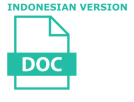Analisis Pembentukan Istilah-Istilah Linguistik dalam Bahasa Korea dan Bahasa Indonesia
Didin Samsudin(1), Jayanti Megasari(2*), Risa Triarisanti(3), Ashanti Widyana(4), Hima Ragillia Dwinanda Putri Mahendra(5)
(1) Universitas Pendidikan Indonesia
(2) Universitas Pendidikan Indonesia
(3) Universitas Pendidikan Indonesia
(4) Universitas Pendidikan Indonesia
(5) Universitas Pendidikan Indonesia
(*) Corresponding Author
Abstract
This study was conducted to fulfill the need of students to understand linguistics courses in the Korean Language Education Study Program. The student’s understanding of linguistics starts from their ability to understand the linguistic terms. This study deals with the formation of linguistic terms in Korean language compared to their formation in Indonesian language. It is necessary to analyze Indonesian terms’ formation to find their equivalent terms. It is found that Korean linguistic terms are generally changed into Indonesian as a whole. Although some terms originate from foreign languages, the majority have undergone adaptation and adjustments to be more comprehensible. In contrast, Indonesian linguistic terms are influenced by their source language. Meanwhile, Indonesian linguistic terms are influenced by the language of origin. The formation of terms is also analyzed based on the word formation process by using morphological theory to determine the formation pattern. This research may answer the function of these terms in the process of understanding linguistics lectures at the Korean Language Education Study Program, FPBS, UPI.
Keywords
Full Text:
PDFReferences
Sujana, Budiwaty, S. (2014). Strategi Pembentukan Istilah Asing Dalam Penyusunan Glosarium Terminologi Penerjemahan Inggris-Indonesia. UG Jurnal, 1(1), 18–20. https://ejournal.gunadarma.ac.id/index.php/ugjournal/article/view/1194
Cabré, M. T. (2003). Theories of terminology, their description, prescription and explanation. Terminology, 9(2), 163–199. https://doi.org/10.1075/term.9.2.03cab
Chaer, A. (2007). Linguistik Umum. Rineka Cipta.
Chaer, A. (2008). Morfologi Bahasa Indonesia (Pendekatan Proses). Rineka Cipta.
Eom, T. G. (2019). A Study on the Lexical-Morphology of Terminology in Korean. Hanyang University.
Im, H.B. (2003). A Study on the Classification System of Korean Linguistics Terms. National Institute of Korean Langua.
Kang, H. H. (2016). Issues in Terminology Research. Narasarang, 125, 191–215.
Karyono.S, S. (2015). Pengolahan Data Statistik di Era Informasi. Elex Media Komputindo.
Kim, C. S. (2008). Korean Morphology Research. Thaehaksa.
Kridalaksana, H. (2009). Kamus Linguistik. PT Gramedia Pustaka.
Megasari, Jayanti. (2022). A Contrastive Analysis of Food Name Forming Korea and Indonesia: A Morphological Study. Journal of Korean Applied Linguistics, 2(1), 57–58. https://ejournal.upi.edu/index.php/JoKAL/article/view/43852
Parera, J. D. (n.d.). No Title. PT Gramedia Pustaka.
Ramlan. (2009). Morfologi: Suatu Tinjauan Deskripstif. Universitas Gadjah Mada.
Seob, L. I. (2016). Korean Language Studies Established. Hakyeonsa.
Suwardjono. (1990). Kridalaksana dalam Simpen (2015) (K. P. dan K. Indonesia, Ed.).
Wardhaugh. (1972). Reading: A Psycholinguistic Perspective. Harcourt, Brace, and World.
Webster, M. (1981). Webster’s New Collegiate Dictionary. MerriamWebster, Inc.
Article Metrics
Refbacks
- There are currently no refbacks.
Copyright (c) 2023 The Author(s)

This work is licensed under a Creative Commons Attribution-ShareAlike 4.0 International License.







